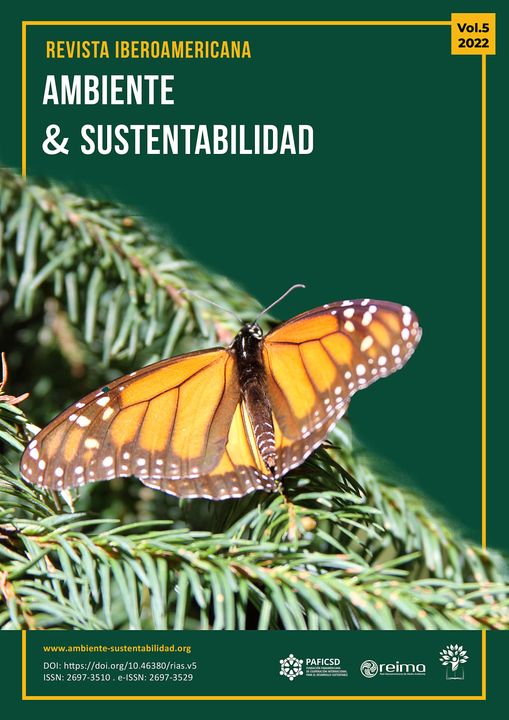Biofiltración de aguas residuales de industrias arroceras de San Jacinto de Yaguachi, Ecuador mediante cascarilla de arroz
DOI:
https://doi.org/10.46380/rias.vol5.e271Palabras clave:
carbonización, carbón activado, contaminación ambiental, economía circular, eutrofización, sólidos totalesResumen
Se estima que en el mundo más del 80% de las aguas residuales generadas por actividades antropogénicas son vertidas de manera directa al ambiente. La descarga de estas aguas es una problemática todavía sin resolver en las ciudades, y por ello se requieren de tecnologías económicas a implementarse a nivel doméstico. Ante esta problemática, el presente trabajo tuvo como objetivo evaluar la eficiencia de un biofiltro utilizando sustratos de carbón activado y ceniza (producidos a partir de cascarilla de arroz) para el tratamiento de aguas residuales domésticas. La activación de los sustratos se llevó a cabo mediante procesos fisicoquímicos a temperaturas de 450 °C y con el uso de ácido fosfórico. Como resultado de la biofiltración del agua residual, la ceniza permitió una remoción de color verdadero (Pt-Co) de hasta 99%. El carbón activado redujo la turbidez hasta un 95.3%; mientras que el contenido de sólidos totales no fue prácticamente disminuido por ninguno de los sustratos. La presente investigación se vincula con la economía circular dado el empleo de un residuo de producción como es la cáscara de arroz.
Descargas
Métricas
Citas
Adams, F. V. y Mulaba-Bafubiandi, A. F. (2014). Application of rice hull ash for turbidity removal from water. Physics and Chemistry of the Earth, 72–75, 73–76. https://doi.org/h92z
Ahmaruzzaman, M. y Gupta, V. K. (2011). Rice husk and its ash as low-cost adsorbents in water and wastewater treatment. Industrial & Engineering Chemistry Research, 50(24), 13589–13613. https://doi.org/crh3wb
Ajmal, M., Rao, A. K. R., Anwar, S., Ahmad, J. y Ahmad, R. (2003). Adsorption studies on rice husk: removal and recovery of Cd (II) from wastewater. Bioresource Technology, 86(2), 147–149. https://doi.org/dhptpz
Alam, M., Hossain, A., Hossain, D., Johir, M. A. H., Hossen, J., Rahman, S., Zhou, J. L., Hasan, A. T. M. K., Karmakar, A. K. y Ahmed, M. B. (2020). The potentiality of rice husk-derived activated carbon: from synthesis to application. Processes, 8(2), 203. https://doi.org/h925
American Society for Testing and Materials. (2018). Standard Test Methods for Filterable Matter (Total Dissolved Solids) and Nonfilterable Matter (Total Suspended Solids) in Water. ASTM International
Ataguba, C. O. y Brink, I. (2021). Design and construction of laboratory-scale activated carbon, gravel, and rice husk filter columns for the treatment of stormwater runoff from automobile workshops. Journal of the South African Institution of Civil Engineering, 63(1). https://doi.org/h95w
Banco Mundial. (19 de marzo de 2020). El agua residual puede generar beneficios para la gente, el medioambiente y las economías, según el Banco Mundial [Comunicado de prensa]. https://bit.ly/3AFHXXn
Corporación Financiera Nacional. (2021). Agricultura e industria manufacturera. Cultivo de arroz. Ficha Sectorial Arroz. https://bit.ly/3Q9VDiX
Goddard, F. G. B., Pickering, A. J., Ercumen, A., Brown, J., Chang, H. H. y Clasen, T. (2020). Faecal contamination of the environment and child health: a systematic review and individual participant data meta-analysis. The Lancet Planetary Health, 4(9), e405–e415. https://doi.org/h957
Instituto Nacional de Normalización. (1998). Agua. Calidad del agua. Muestreo. Manejo y conservación de muestras (1ª ed.). https://bit.ly/3BjWjNn
Khalil, U., Shakoor, M. B., Ali, S., Ahmad, S. R., Rizwan, M., Alsahli, A. A. y Alyemeni, M. N. (2021). Selective removal of hexavalent chromium from wastewater by rice husk: Kinetic, isotherm and spectroscopic investigation. Water, 13(3), 263. https://doi.org/h96b
Le Van, K. y Luong, T. T. (2014). Activated carbon derived from rice husk by NaOH activation and its application in supercapacitor. Progress in Natural Science: Materials International, 24(3), 191–198. https://doi.org/ggqm7r
Li, M. y Xiao, R. (2019). Preparation of a dual pore structure activated carbon from rice husk char as an adsorbent for CO2 capture. Fuel Processing Technology, 186, 35–39. https://doi.org/h96d
Luo, Y., Li, D., Chen, Y., Sun, X., Cao, Q. y Liu, X. (2019). The performance of phosphoric acid in the preparation of activated carbon-containing phosphorus species from rice husk residue. Journal of Materials Science, 54, 5008–5021. https://doi.org/gp4n7d
Masoud, M. S., El-Saraf, W. M., Abdel - Halim, A. M., Ali, A. E., Mohamed, E. A. y Hasan, H. M. I. (2016). Rice husk and activated carbon for wastewater treatment of El-Mex Bay, Alexandria Coast, Egypt. Arabian Journal of Chemistry, 9(2), S1590–S1596. https://doi.org/h96w
Mateo-Sagasta, J., Marjani-Zadeh, S., Turral, H. y Burke, J. (2017). Water pollution from agriculture: A global review. Food and Agriculture Organization of the United Nations/International Water Management Institute. https://bit.ly/3cIqIwx
Menya, E., Olupot, P. W, Storz, H., Lubwama, M. y Kiros, Y. (2020). Synthesis and evaluation of activated carbon from rice husks for removal of humic acid from water. Biomass Conversion and Biorefinery, 12, 3229–3248. https://doi.org/gjg9dm
Ministerio del Ambiente. (2015). Norma de calidad ambiental y de descarga de efluentes: Recurso Agua. Anexo 1 del libro VI del Texto Unificado de Legislación Secundaria del Ministerio del Ambiente. https://bit.ly/3LlM9jJ
N’Diaye, A. D., Boudokhane, C., Kankou, M. y Dhaouadi, H. (2019). Potential of rice husk ash in atrazine removal. Chemistry and Ecology, 35(7), 678–692. https://doi.org/h96z
Organización de las Naciones Unidas para la Alimentación y la Agricultura. (2016). Seguimiento del mercado del arroz de la FAO (Vol. XIX) https://bit.ly/3Qfu0oC
United Nations-Water. (2022). UN World Water Development Report. United Nations. World Water Development Report 2022. https://bit.ly/3BxxJKb
Walker, D. B., Baumgartner, D. J., Gerba, C. P. y Fitzsimmons, K. (2019). Surface water pollution. In M. Brusseau, I. Pepper, Ch. Gerba (Eds.), Environmental and pollution science (pp. 261–292). Elsevier. https://doi.org/h967
Wurtsbaugh, W. A., Paerl, H. W. y Dodds, W. K. (2019). Nutrients, eutrophication, and harmful algal blooms along the freshwater to marine continuum. Wiley Interdisciplinary Reviews: Water, 6(5). https://doi.org/ghwt7s
Zahid, I., Hussain, S., Malghani, N., Naeem, Z., Amin, M., Mushtaq, F. y Anwer, A. (2016). Municipal wastewater treatment using rice husk and kikar charcoal as activated carbon. International Research Symposium on Engineering Advancements, 2016. https://bit.ly/3KIEuvG
Publicado
Cómo citar
Número
Sección
Licencia
Derechos de autor 2022 Xavier Andrés Iturralde Jácome, Arturo Andrés Hernández Escobar

Esta obra está bajo una licencia internacional Creative Commons Atribución-NoComercial-CompartirIgual 4.0.













